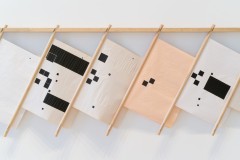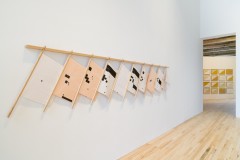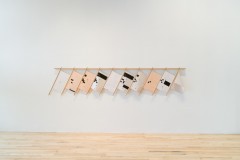The Mourning Herald decontextualizes a familiar system of signs—a process of deconstruction that, Çavuşoğlu explains, “spoons[s] things out from the ‘wholeness’ to give us the opportunity to look at so-called intact structures again.” In The Mourning Herald, Çavuşoğlu addresses the visual language of public mourning that has evolved on social media including Facebook: in recent years, individual users have begun to show solidarity with victims of tragedies by changing their profile pictures or backgrounds to solid black. Çavuşoğlu realized that while she might sometimes look at her feed and immediately know what a given friend is mourning, at other times the cause for their grief is unknown. The Mourning Herald makes visible the gaps in understanding and experience that persist in the digital age, despite the immediate access to knowledge and sense of connection that the internet seems to offer.
Çavuşoğlu’s The Mourning Herald also touches on the way in which personal history is constituted online—each print acts as a time capsule of the artist’s Facebook feed after particular tragedies beginning in 2014, attesting to shared moments of grief. In the storied preface to her translation of Jacques Derrida’s On Grammatology, Gayatri Chakravorty Spivak writes that in order to contemplate itself, “the self cannot remain within the ‘simple now-ness of a Living Present,” it must give itself a history, differentiate itself from itself through a backward glance which also makes possible a forward glance.” This moment of the constitution of the (self-considering) self through the construction of a personal history has a parallel in the process through which personal histories—or memories—become shared History.
Silk-screened print on newsprint, wood rack, 381×89 cm. Commissioned by MASS MoCA with the support of SAHA.
*Excerpt from the exhibition text by Alexandra Foradas
In the smallest of the spaces, old-fashioned newspaper sticks — the kind that bind sections with a wooden spline, for easier reading — dangle with a half-dozen broadsheets. Their pages hold rectilinear blocks of black ink, floating on yellowed newsprint, with not a word among them. They’re spare, ominous and darkly beautiful, even more so when you learn what they are. Çavuşoğlu calls the work “The Mourning Herald,” a graphic representation of violent tragedies as seen in her social media feed. It became common some years ago, as an act of collective digital mourning, for people to either blot out their profile photos or post black space where a picture might be. The effect, ultimately, obscures and abstracts reality — what social media does best.


